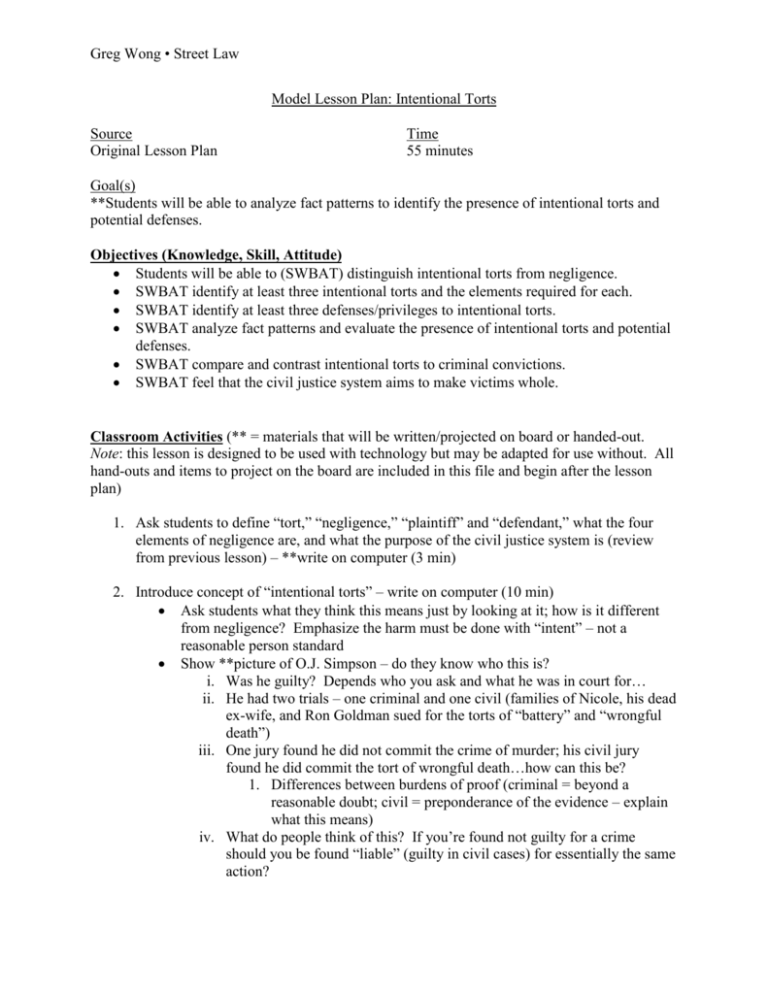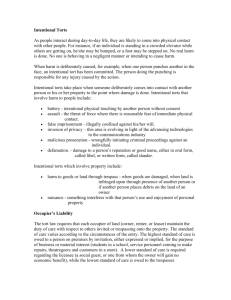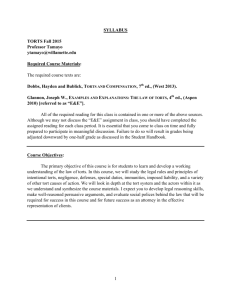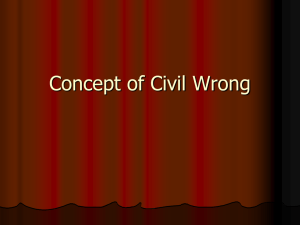Greg Wong - University of Washington School of Law
advertisement

Greg Wong • Street Law Model Lesson Plan: Intentional Torts Source Original Lesson Plan Time 55 minutes Goal(s) **Students will be able to analyze fact patterns to identify the presence of intentional torts and potential defenses. Objectives (Knowledge, Skill, Attitude) Students will be able to (SWBAT) distinguish intentional torts from negligence. SWBAT identify at least three intentional torts and the elements required for each. SWBAT identify at least three defenses/privileges to intentional torts. SWBAT analyze fact patterns and evaluate the presence of intentional torts and potential defenses. SWBAT compare and contrast intentional torts to criminal convictions. SWBAT feel that the civil justice system aims to make victims whole. Classroom Activities (** = materials that will be written/projected on board or handed-out. Note: this lesson is designed to be used with technology but may be adapted for use without. All hand-outs and items to project on the board are included in this file and begin after the lesson plan) 1. Ask students to define “tort,” “negligence,” “plaintiff” and “defendant,” what the four elements of negligence are, and what the purpose of the civil justice system is (review from previous lesson) – **write on computer (3 min) 2. Introduce concept of “intentional torts” – write on computer (10 min) Ask students what they think this means just by looking at it; how is it different from negligence? Emphasize the harm must be done with “intent” – not a reasonable person standard Show **picture of O.J. Simpson – do they know who this is? i. Was he guilty? Depends who you ask and what he was in court for… ii. He had two trials – one criminal and one civil (families of Nicole, his dead ex-wife, and Ron Goldman sued for the torts of “battery” and “wrongful death”) iii. One jury found he did not commit the crime of murder; his civil jury found he did commit the tort of wrongful death…how can this be? 1. Differences between burdens of proof (criminal = beyond a reasonable doubt; civil = preponderance of the evidence – explain what this means) iv. What do people think of this? If you’re found not guilty for a crime should you be found “liable” (guilty in civil cases) for essentially the same action? Show **“Mischievous Child” fact pattern on screen – did Dailey act intentionally? Can Dailey be sued by Garrett and forced to pay for her injuries? Can Dailey’s parents be sued? Does it matter that he didn’t want her to get hurt? (all that matters for intent is that he knew she would fall) Causes of Intent: Motive, Insanity, Poverty, Mistake (kill dog thinking it was wolf) not relevant to Intent in torts ** (show on computer after Dailey discussion) Intent must have one of two components: 1. Want, desire, purpose, for the consequence to happen, OR 2. Know to a substantial certainty that the consequence will happen 3. Pass out **Intentional Torts and Definitions hand-out (and have on computer): Battery: Must have: 1) intent, 2) a volitional (purposeful) act, 3) a harmful or offensive contact, and 4) to the plaintiff’s person False Imprisonment: For false imprisonment, defendant must intend to: 1) Restrain; 2) plaintiff’s physical liberty; 3) and the harm plaintiff suffers is loss of freedom Intentional Infliction of Mental Distress (IIMD) aka “Outrage”: Must be (1) “intentionally” or “recklessly” done and (2) plaintiff must have “severe emotional distress” Conversion: Defendant must intend to take property from the plaintiff or deprive the plaintiff of its use. 4. **Scenarios: Have students act out scenarios included below in front of class to demonstrate each tort; after the scene, have students identify each element in the tort (5 min) 5. **Group problem (on computer)(5 min): Read the “Group Problem” included below and have students identify potential torts and identify who is the plaintiff and who is the defendant for each claim (fill out chart under scenario that says P/D/Intentional Tort as they talk). 6. Pass out the **”Fact Pattern” (included below) and have students work in pairs to identify what torts. Share their results. (10 min) 7. Go over **Defenses to Intentional Torts (on computer and hand out) Consent Self-Defense Defense of Others Defense of Property Recapture of Converted Property Privilege of Public Necessity – acting to protect interests of the public 8. What defenses can be claimed in the Group Problem (fill in “Potential Defenses” on chart on the computer)? What about in the “Fact Pattern”? (4 min) 2 9. In partners create one fact pattern that contains an intentional tort and a possible defense. Share (if there is time) and turn in. (10 min) 10. Wrap-up: summarize intentional torts and defenses Evaluation Assess student ability to create a fact pattern that accurately describes an intentional tort and a defense. Assess student ability to correctly identify all intentional torts and potential defenses in the Group Problem as a class and in the Fact Pattern individually. Materials Needed o Computer and projector o Copies of Intentional Torts and Defenses Handout for each student o Scenarios (2 of each) o Copies of Fact Pattern for each student 3 Tort: Negligence: Elements: 1. 2. 3. 4. Plaintiff: Defendant: Purpose of Civil Justice System: Intentional Tort: “The Juice” Nicole Brown Ron Goldman 4 The Mischievous Child: Dailey, a 5-year-old child, was playing in the backyard when an elderly woman, Garrett, went outside to sit down. The child pulled the lawn chair away just before Garrett sat down, and Garrett fell to the ground and fractured her hip. Although Dailey did not want to hurt Garrett and did not believe she would be hurt, the child was aware that if he pulled the chair away as Garrett was sitting down she would almost certainly land on the ground. Intent must have one of two components: 1. Want, desire, purpose, for the consequence to happen, OR 2. Know to a substantial certainty that the consequence will happen 5 Intentional Torts and Definitions Battery: Must have all four of these elements: 1) intent, 2) a volitional act (one done by choice), and 3) a harmful or offensive contact 4) to the plaintiff’s person False Imprisonment: For false imprisonment, defendant must intend to: 1) Restrain, 2) plaintiff’s physical liberty, 3) and the harm plaintiff suffers is loss of freedom Intentional Infliction of Mental Distress (IIMD) aka “Outrage”: Must be: 1) “intentionally” or “recklessly” done and 2) plaintiff must have “severe emotional distress” Conversion: Defendant must intend to take property from the plaintiff or deprive the plaintiff of its use. Defenses to Intentional Torts These are defenses the defendant can claim in court to show that they are not liable for the injury to the plaintiff: Consent – if the plaintiff consented for the action to be done. Self-Defense Defense of Others Defense of Property Recapture of Converted Property Privilege of Public Necessity – acting to protect interests of the public 6 Group Problem: Kathleen, 17 is at the mall. She goes into a store and quickly slips an iPod under her jacket. Thinking no one has noticed, she turns to leave the store. The store manager, however, was watching her on a security camera. As soon as she passes the cash register the store security guard hits her over the head with a club and knocks her out. He drags her to a storage room in the back of the store. When Kathleen wakes up an hour later the security guard holds up a knife and pair of brass knuckles and threatens to torture her if she doesn’t confess to taking the iPod. After Kathleen gives the iPod back, the security guard tells her that he is going to leave her in the room with no food and water until she dies as punishment for her moral corruption. He puts a gun to her head and says if she tries to leave he will hurt her family as well. He then spits on her and leaves with the door unlocked. Ten hours later the store owner comes in and takes her to the police station. What torts? Are there crimes as well? Plaintiff Defendant Intentional Tort 7 Potential Defenses Fact Pattern Fisher, an African American mathematician who worked for a government agency, was attending a conference at the Carrousel Motor Hotel in Texas in 1967. While in line at the cafeteria waiting to pay for his lunch, an employee of the hotel, Darryl, snatched the tray from out of Fisher’s hand and shouted: “Nig--rs ain’t served in this club.” Fisher was not physically harmed, but he was shocked and embarrassed in front of his colleagues. To clean himself up Fisher uses one of the hotel’s towels. Darryl has a speech impediment and often stutters. He has been made fun of relentlessly at work and has told his co-workers to stop teasing him. Darryl’s boss, Vanessa, hears about what Darryl did to Fisher and decides he needs to be punished. She tells Darryl that he will be fired if he doesn’t stand in the hotel’s walk-in freezer (which has a window) and let every other employee make fun of him. At the end of the day Vanessa gathers all the employees in front of the freezer and mocks Darryl’s low intelligence and constant stuttering. She then turns off the lights, tells Darryl she is locking the door and leaves. A few hours later, Darryl realizes the door is not locked and he leaves. Darryl suffers frostbite on his toes and fingers as a result of his time in the freezer. When Fisher leaves the conference he takes the towel he used to clean himself up with him as a reminder of the racism that still exists in this world. He also sees Darryl when he is leaving and attempts to punch him in the fact. Darryl ducks and Fisher accidentally hits his friend Ivana. What torts? Are there crimes as well? Plaintiff Defendant Intentional Tort 8 Potential Defenses Battery Scenario - Student 1 and Student 2 are walking down the hall at school in opposite directions. - The students accidentally bump shoulders as they pass each other - Student 1 slaps/hits the other student and tells them to be more careful False Imprisonment Scenario Teacher: Thank you for coming to this class meeting. I know it is after school on Friday but I have something important to say. I suspect that some of you cheated on the last test. As punishment all of you must stay in this room for the entire weekend. If any of you try to leave I will fail you. I will also be waiting outside in the hallway with my Tazer gun if you attempt to leave. That should teach you all a lesson! Intentional Infliction of Emotional Distress Scenario Pat: (Looking scared) Oh no, here comes Lucky Eddie, that enforcer from the mob! Lucky Eddy: So Pat, have you signed the contract yet? Pat: I told you I can’t sign that contract, it would be illegal! Lucky Eddy: Well too bad for you…we’re going to come for you and break all of your fingers. Then we’re going to do the same to your wife while you watch. After that we’re going to kill you both. I’m not going to tell you what we’re going to do with your kids…I’ll leave it to your imagination. (Lucky Eddy leaves) Pat: Oh my gosh, what am I going to do! This is freaking me out! My heart...it’s beating so fast! I think I’m going to have a heart attack!! (Clutches chest and falls down) 9 Conversion Scenario Student 1: Hey, why don’t you let me borrow your snowboard this time down the mountain? Student 2: No, just because you broke yours doesn’t mean you can use mine! Student 1: (Grabs snowboard and takes off) See ya sucker!! Student 2: Hey, come back here!! 10







